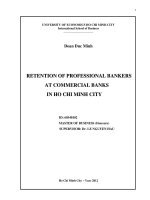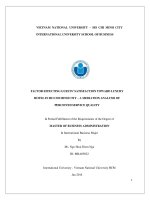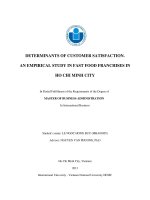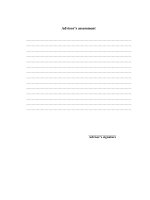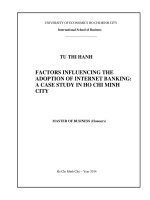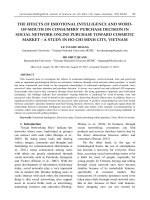Determinants of customer satisfaction an empirical study in fast food franchises in ho chi minh city
Bạn đang xem bản rút gọn của tài liệu. Xem và tải ngay bản đầy đủ của tài liệu tại đây (1.24 MB, 63 trang )
DETERMINANTS OF CUSTOMER SATISFACTION.
AN EMPIRICAL STUDY IN FAST FOOD FRANCHISES IN
HO CHI MINH CITY
In Partial Fulfillment of the Requirements of the Degree of
MASTER OF BUSINESS ADMINISTRATION
In International Business
Student’s name: LE NGOC HONG BUU (MBA03005)
Advisor: NGUYEN VAN PHUONG, Ph.D
Ho Chi Minh City, Vietnam
2013
International University - Vietnam National University HCMC
DETERMINANTS OF CUSTOMER SATISFACTION.
AN EMPIRICAL STUDY OF FAST FOOD
FRANCHISES IN HO CHI MINH CITY
APPROVED BY Advisor
APPROVED BY: Committee
__________________________
_________________________________
Nguyen Van Phuong Ph.D
_________________________________
_________________________________
_________________________________
_________________________________
_________________________________
THESIS COMMITEE
ACKNOWLEDGEMENTS
I would like to give thanks and appreciates for the following individuals
First of all, i am really thankful to my advisor, Dr. Nguyen Van Phuong. Without his help, i
would not able to finish this thesis. Through his advices, and guidance, my thesis was formed
and built. I could not thank him enough for the patience and endurance he had for my mistakes
throughout thesis completing.
Secondly, i would like to express my gratitude to Dr. Nguyen Quynh Mai and Dr. Phan Trieu
Anh for their advices and comments in the last stage of my thesis.
Finally, i am grateful to my family and my friends who unendingly cover me by their loves, who
never fail to give me their supports and encouragements. I love you all!!!
And above all, I want to give thanks to my God for His faithfulness toward me, for His love that
poured out on me and for the amazing plan He has prepared for my life.
Contents
ACKNOWLEDGEMENTS ............................................................................................................ 5
ABSTRACT .................................................................................................................................... 8
CHAPTER I - INTRODUCTION ................................................................................................ 9
1.1 Research background ............................................................................................................ 9
1.2 Problem statement ............................................................................................................... 10
1.3 Research Question .............................................................................................................. 11
1.4 Research objectives ............................................................................................................. 11
1.5 Contribution of the research................................................................................................ 11
1.6 Research structure ............................................................................................................... 11
CHAPTER 2 - LITERATURE REVIEW & RESEARCH MODEL............................................ 13
2.1 Fast food industry ............................................................................................................... 13
2.2 Customer Satisfaction ......................................................................................................... 14
2.3 Factors that affect Customer Satisfaction ........................................................................... 16
2.3.1 Service quality ............................................................................................................. 17
2.3.2 Product quality ............................................................................................................. 18
2.3.3 Price ............................................................................................................................. 19
2.3.4 Situational factors ........................................................................................................ 19
2.3.5 Personal factors ............................................................................................................ 19
2.5 Proposed research model and hypotheses ........................................................................... 20
CHAPTER 3 - RESEARCH METHODOLOGY ......................................................................... 21
3.1Research design ................................................................................................................... 21
3.2 Research Process ................................................................................................................. 22
3.3 Data collection .................................................................................................................... 23
3.3.1 Secondary Data ............................................................................................................ 23
3.3.2Type of respondents of survey ...................................................................................... 23
3.4 Measurement for Customer Satisfaction ............................................................................. 23
3.5 Pilot testing ......................................................................................................................... 25
3.6 Questionnaire design........................................................................................................... 25
3.7 Sample Size ......................................................................................................................... 25
3.8 Data analysis techniques ..................................................................................................... 26
3.8.1 Reliability Test (Cronbach’s Alpha) ............................................................................ 26
3.8.2 Exploratory Factor Analysis (EFA) ............................................................................. 26
3.8.3 Linear regression analysis ............................................................................................ 26
3.8.4 Independent sample T-test and One-way Anova ......................................................... 26
CHAPTER 4 – DATA ANALYSIS & FINDINGS ...................................................................... 28
4.1 Coding data ......................................................................................................................... 28
4.2 Data Analysis results........................................................................................................... 29
4.2.1 Demography profile ..................................................................................................... 29
4.2.2 Descriptive statistic ...................................................................................................... 33
4.2.3 Reliability test .................................................................................................................. 35
4.2.4 Factor analysis and Validity test .................................................................................. 39
4.2.5 Rename factors............................................................................................................. 44
4.2.6 Empirical model ........................................................................................................... 45
4.2.7 Test model & research hypotheses .............................................................................. 46
4.2.8 Linear equation of Customer Satisfaction in Fast food ............................................... 48
4.2.9 T-test and ANOVA ...................................................................................................... 49
4.3 Discussion and Recommendation ....................................................................................... 50
4.3.1 Price ............................................................................................................................. 50
4.3.2 Service Quality............................................................................................................. 51
CHAPTER 5- CONCLUTION & RECOMMENDATIONS ....................................................... 52
5.1 Conclusion .......................................................................................................................... 52
5.2 Limitation and suggestion ................................................................................................... 53
References ..................................................................................................................................... 54
Appendix 1:................................................................................................................................... 57
Appendix 2:................................................................................................................................... 60
ABSTRACT
The aim of this study is about to find out how fast food consumers satisfied by their preferred
fast food franchises as well as to explore the most influencing factors of customer satisfaction.
Theoretical framework of Zeithaml and Bitner (2000) of Customer Satisfaction was used to
develop measurement scale in the context of Fast food franchise in Ho Chi Minh City. Data was
collected and processed by SPSS software with five factors: Service Quality, Product Quality,
Price, Situation Factor and Personal Factor. Result of this research shows the relative satisfaction
level of customers and factors which most impact on satisfaction are Price are Service Quality. A
new model is suggested for being more suitable in conditions of fast food marketplace in Ho Chi
Minh City.
CHAPTER I - INTRODUCTION
1.1 Research background
Bennet & Rundle-Thiele (2004) had indicated that customer satisfaction is an important issue for
many marketing managers. It is commonly used as a marketing benchmark of a company’s
performance. Therefore, customer satisfaction is considered as a factor encouraging customers to
use the service again, although there is no guarantee that a satisfied customer will return for a
repeat purchase (Soriano, 2002). Moreover, regardless of size or industry, the business that is
best at retaining customers will benefit from lower marketing costs, greater brand value, less
customer sensitivity to price, and improved long-term financial performance (Oracle, 2003).
To make customers satisfied with products and services which are considered as most important
factor leading toward competitiveness and success, company have to improve their product and
service quality and offer a competitive price. Therefore, many previous studies have attempted to
find out which determinants impact on customer satisfaction. Recently, many studies have
focused on the relationship between customer satisfaction and service quality and price in fast
food industry in many other countries. For instance, Ling et al (2011), conducting a survey with
200 Malaysian customers, evaluate and validate the determinants of the customer loyalty in the
western fast food industry in Malaysia. Another study of cross-cultural comparison of service
satisfaction of fast food establishments in four English-speaking countries, Gilbert et al (2004)
proved “satisfaction dimensions: satisfaction with the personal service and satisfaction with the
service setting”. However, there is a little research customer satisfaction in fast food industry in
Vietnam. Therefore, the author would like to investigate the relationship between customer
satisfaction with product quality, service quality and price in the fast food industry in Ho Chi
Minh City.
The enhancement of economy development has resulted in changing of consumer behaviours in
Vietnam especially in Ho Chi Minh city, the most dynamic economy with GDP per capital last
year was 3,700.00.USD (Annual Economic Report in December, 2012). Along with rapid growth
of economy, the living standards have been lifted and their life styles become busier and more
dynamic. Ho Chi Minh City is the centre point of culture exchange; it is easily to adopt Western
lifestyles and cuisine. Therefore, fast food industry is seen as fashionable and attractive.
From the first day being in Ho Chi Minh city in 1997 until now, with the enter of Kentucky Fried
Chicken also well known as KFC, fast food industry has leaped a big step in the food retail
services. The profits have increased annually and competitions among brand names and
franchises have become dramatically from both local and international retailers. Ho Chi Minh
City is considered as the most attractive market for fast food industry all over Asia. In 2011, fast
food industry got a significant increasing 30% of total revenue comparing to 2010 (Ministry of
Industry and Trade, 2011).
Young people who hold the greatest percentage of population are core customers of fast food
market in Ho Chi Minh City. Elias Diaz Sese, Director of Burger King Asia Pacific, stated
“young population makes favorable for the marketplace as youngsters always love to try new
products.” Besides Burger King is a new entrant, in last August, other fast food brand names
such Johnny Rocket, Dunkin Donuts and Mc Donald are planning to enter the fast food market in
Vietnam. The local fast food market will going to be more competitive and it will change the
market shares, as more players jump into the market. As Le Hoi Nam, Marketing Director of
KFC, stated, “Appearances of new comers to fast food industry was expected, this would make
the battle among fast food brand names more fierce than ever”
Another research of FTA in June 2012 customers in Ho Chi Minh concern more on waiting time
and they would want to be served quickly while having fast food. Moreover, According to AC
Nielsen (2010), 42 percent of respondents wanted to eat fast foods and 86 percent of fast food
users are in the age from 20 to 35, people in the age from 20 to 30 used fast foods more
frequently, accounting for 76 percent of fast food eaters. Besides, fast food restaurants are well
decorated and the ambience in restaurants is cool and comfortable. So, fast food restaurants
become popular in any big city in Vietnam, particular in Ho Chi Minh city.
1.2 Problem statement
Fast food is growing fast and speedy in Vietnam especially in Ho Chi Minh city; however,
research which is conducted in this field is rare. Mostly, researches of fast food in Vietnam are
about customer satisfaction in one specific brand name. Thus, we want to examine which
determinants affect on customer satisfaction in the fast food industry. We conduct a survey with
350 respondents who have been eating at least one fast food store in Ho Chi Minh city.
Furthermore this study is also to compare brand names of fast food companies. Consumers
always have their favorite fast food brands in mind and the aim of this research is to point out
which components would define satisfaction of customers for their choice brands, why they
would be more satisfied by their favorite brands but not one another?
At the moment, most of the fast food restaurants belong to foreign brands or international
franchises. Local brands have not established their own yet in this “battlefield”. The findings
enable Vietnamese companies to recognize main factors affecting customer satisfaction in some
leading fast food franchise in Vietnam and to learn from those facts. Our recommendations may
help Vietnamese enterprises to find a better solution to improve service quality and offer a
competitive price in order to meet customer satisfaction in this quick restaurant services.
1.3 Research Question
1. What is the current customer satisfaction of customer with their fast food favourite brand
names?
2. What are factors that affect customer satisfaction when having fast food of their favourite
brands?
1.4 Research objectives
The purposes of this study is
-
to examine the influence factors that have impact on satisfaction of customers when
having fast food
-
to evaluate the overall satisfaction of fast food consumers for their preferred franchise
-
to suggest improvements based on research findings
1.5 Contribution of the research
Generally, the findings of this study can help restaurant managers to be aware of the importance
of factors which have a positive impact on customer satisfaction. Moreover, the study also comes
up with specific solutions to meet customer satisfaction. From collected data, managers might
have an insight about customers’ needs and current satisfaction of customers about fast food
industry in Ho Chi Minh City.
1.6 Research structure
Chapter 1: Introduction
This chapter introduces research background, states research problems and objectives in order to
give an idea what this research is about to solve
Chapter 2: Literature review and research model
This chapter provides concepts, key theories which related and supports for this study and based
on mentioned theories, a theoretical framework, research model and hypotheses are suggested.
Chapter 3: Methodology
The chapter shows in details research design, predicted measurement scale and questionnaire as
well as procedures and methods used in data processing
Chapter 4: Data analysis, discussion and recommendations
This chapter describes and analyzes the outcomes from data solving step. It also presents
empirical model of study after confirming hypothesis. Besides, some recommendations are given
base on research findings.
Chapter 5: Conclusion and Limitation
The chapter gives conclusion from research results as well as limitation of the study and
suggestions for further study.
CHAPTER 2 - LITERATURE REVIEW & RESEARCH MODEL
2.1 Fast food industry
According to Merriam Webster Dictionary, fast food is a term that relates to or specializes in
food that can be prepared and served quickly. The fast food industry, also known as Quick
Service Restaurants (QSR), has been serving for as long as people have lived in cities. Its
concept is generally associated with urban development. The modern system of fast food
franchising is believed to have started in the middle of 1930s when Howard Johnson franchised
his second location to a friend as a means to expand operations during the Great Depression.
The Fast Food Restaurants industry is only one component of the wider food service sub-sector,
including cafes, cafeterias, full-service restaurants, casual dining, coffee shops, street stalls and
takeout stands. Fast food is most well-known in forms of hamburgers, French fries, pizzas,
donuts, fried chickens and so on. Recently, Fast food companies have been franchised in over
100 countries. In the U.S. alone there are over 200,000 restaurant locations. The Global industry
is estimated to account for revenue of $706.7 billion in 2012, or about 38% of the global food
service sub-sector. Industry revenue is estimated to increase at an annualized 2.1% in the five
years through 2012, with a 3.2% increase expected in 2012. (Global Fast Food Restaurant Report
2012).
In Vietnam, fast food industry first started in 1997 following the commencement of KFC and
Lotteria. After six years, the industry revenue still grown very slowly, in 2003, Lotteria and KFC
only got a few restaurants in the whole country. However, scene has changed significantly 3
years after that. In 2007, Lotteria opened the 50th store while KFC had owned 63 restaurants. At
the end of 2012, Lotteria and KFC each brand has reached more than 140 locations while
Jollibee (another well-known franchise from Philippines) got 30 stores. So far, foreign “giants”
like KFC, Lotteria or Jollibee and Pizza Hut have being dominating overall market. They are
holding more than 70% of fast food market. KFC is a leading one with 60% segment within the
industry.
Fast food industry in Vietnam, in 2011, continued to register a rapid growth of 26% in current
value terms due to various reasons. Despite the steep increase in overall food prices, fast food
was able to maintain stable prices, thus making dishes more affordable to consumers. The
modern image of fast food outlets stands for Western life-style that attracts more and more
teenagers and young working adults. Recently, Burger King-a world leading fast food franchise
has opened its first stores in Vietnam, which has drawn so much attention among fast food
consumers. Experts have predicted a “civil war” among these international brand names while
local brand names, in the meantime, get no chance in this battle.
2.2 Customer Satisfaction
The importance of customer satisfaction has been highlighted by many researchers; it is the main
ingredients of success in the market place. (Fornell et al., 1996) Marketers consider satisfying
customers as a key element of business activities especially in competitive market (Anderson,
1994).
Oliver (1997) defined satisfaction as “the consumer’s fulfillment response. It is a judgment that a
production or service feature, or the product or service itself, provided (or is providing) a
pleasurable level of consumption-related fulfillment, including levels of under- or overfulfillment.” On the other hand, Kotler, (2000) called satisfaction as: “a person’s feelings of
pleasure or disappointment resulting from comparing a product’s perceived performance (or
outcome) in relation to his or her expectations”.
Many researchers suggested that consumers are satisfied when the products perform better than
expected, dissatisfied when consumers' expectations exceeded actual product performance, and
neutral satisfaction when the product performance matches expectations (Oliver, 1980)
According to Brink and Berndt (2004), customer satisfaction can be described as the degree to
which an organization’s product of service performance matches up to the expectations of the
customer. The theory is best described by Teboul model.
Figure 1- Teboul Model of Customer Satisfaction - Morgan (1994)
In the model, customers’ needs are represented as a circle while a square depicts products or
service offered by organization. Total satisfaction can be archived when the offers match the
needs. The part that matches with each other shapes is perceived by customers as satisfaction and
the part outside the circle is considered as unnecessary offer. Thus the model expresses an
important notion that organizations should listen to customer opinions to ensure what they are
offering would meet the expectation of customers.
According to La Barbera and Mazursky (1983), “satisfaction influences repurchase intentions
whereas dissatisfaction has been seen as a primary reason for customer defection or
discontinuation of purchase”.
Jochen Wirtz (2003) listed the result of customer satisfaction as follow:
-
Repeating repurchase
-
Loyalty
-
Positive word of mouth
-
Increasing long term profitability
The consequences of not satisfying customers can be severe as for Hoyer and MacInnis (2001),
dissatisfied consumers can decide to:
-
Discontinue purchasing the good or service,
-
Complain to the company or to a third party and perhaps return the item
-
Engage in negative word-of-mouth communication.
For overall, it is likely to lose market share, customers and investors for any business if a
company fails to satisfy customers as effectively and efficiently as its competitors is doing
(Bitner, 1997)
2.3 Factors that affect Customer Satisfaction
Due to many empirical researches about customer satisfaction in various industries, factors that
affect customer satisfaction vary.
Hennig-Thurau and Klee (1997) pointed out that satisfaction of customers with products and
services of a company is considered as most important factor leading toward competitiveness
and success
Bel and Chiao (2001), in another research, stated that product quality and price are both
positively related to consumer satisfaction, which are as equally important as service quality.
None of them can be ignored or partially accented. Figure 2 shows their empirical research
model.
Figure 2
A Practical Model for the Effects of Product Quality, Service Quality and Price on Consumer
Satisfaction and Consumer Loyalty
Base on another study, Bitner (1997) indicated that the extent of satisfaction was broader than
service quality assessment and was subject to the factors of service quality, product quality price
situation and personal factors. For further study, Zeithaml and Bitner (2000) proved that
customer satisfaction is influenced not only by product and service quality and price but also by
situation factors and personal factors.
They presented the model of customer satisfaction with Situation factor and Personal factor
dimensions in Figure 3
Figure 3: Customer Satisfaction model of Zeithaml and Bitner
The theory complies with other studies and has been confirmed by the definition of customer
satisfaction presented by other researchers. For example, Hoyer and MacInnis (2001) also shared
the same idea in saying that satisfaction can be associated with feelings, happiness, relief,
excitement, and delight. Wilson et al. (2008) found the same result that satisfaction generally is
broader than Price, Service and Product, these broader components that affect satisfaction are
situation and personal (Wilson et al., 2008, p. 78).
2.3.1 Service quality
Parasuraman et al. (1985, 1988) defined service quality as the overall evaluation of a specific
service firm that results from comparing that firm's performance with the customer's general
expectations of how firms in that industry should perform. Based on a survey with 200
consumers about five different service categories in 1988, Parasuraman et al. (1988) had
developed a standardized instrument called SERVQUAL, which can be used to measure
customer perceptions of service quality. They then have retested and refined their original
SERVQUAL instrument (Parasuraman et al., 1991). SERVQUAL consists of 22 items
measuring customers’ expectations and another 22 items measuring their perceptions of five
dimensions of service performance. Specifically, they suggested that when consumers make their
judgment of service quality, they would generally consider the service provider’s:
-
Physical facilities and equipment (tangibles);
-
Ability to perform promised service dependably and accurately (reliability);
-
Willingness to help customers and provide prompt service (responsiveness);
-
Knowledge, courtesy and ability to inspire trust and confidence (assurance); and
-
Caring and individualized attention to its customers (empathy).
Most researchers suggested that high service quality resulted in high customer satisfaction.
Bitner (1990) mentioned that good service quality leads to satisfaction, and consumer
satisfaction increased the evaluation of service quality again. A further study, Cronin and Taylor
(1992) proved that service quality was the antecedent of consumer satisfaction by examining
four service industries of banking, pest control, dry-cleaning and fast food. In recent time, Bastos
and Gallego (2008) has provided evidences that service quality directly affects satisfaction.
2.3.2 Product quality
In marketing and economics, quality often has been viewed as dependent on the level of product
attributes ( Hauser and Shugan, 1983; Rosen 1974). Some researchers (Gwin and Lindgren,
1986; Lehtinen and Lehtinen, 1982; Nicholls et al., 1993; Oberoi and Hales, 1990) have
identified customer satisfaction to be based on two service components: the technical quality of
the product. Anderson, Fornell et al. (1994) suggested that it was requirement for customers to
experience with a product to determine how satisfied they were. Similarly, Oliver (1981) showed
that customer satisfaction was the comments made by the surprising experience of product
obtainment or consumption. Fornell (1992) also pointed out that customer satisfaction was the
overall measurement after a customer had purchased the product or used the service. To observe
the relationship between product quality and customer satisfaction, Parasuraman et al (1994)
developed the satisfaction model and proved that product quality was an important factor that
affected consumer satisfaction.
2.3.3 Price
Price has been considered a significant component in explaining consumer satisfaction (Chen et
al. 1994). From the customer perspective, price is the amount which needs to be paid to obtain
the product (Hawkins et al. 1983). Coming up with the same objective, Varki and Colgate (2001)
also pointed out that price was the part that required payment or sacrifice to obtain the products
or services. And at the end of the process, customers would have price awareness of product, the
purchase behavior of customers depended on pricing factors. A further study, Anderson et al.
(1994) emphasized price as an important factor that directly impacted on consumer satisfaction,
because whenever consumers evaluate the value of an acquire service, they usually think of the
price. In general, the lower the price is, the lower perceived sacrifice is (Zeithaml 1988).
Rationally, low perceived price does ensure higher satisfaction. (Bei and Chiao 2001)
In the food consumption behavior, price should be an important factor affecting customer’s
inertia and satisfaction (Cheng et al 2010).
2.3.4 Situational factors
Situational factor is defined as service performance condition that customers view as beyond the
service provider. It includes some uncontrollable features such as consuming experience of
customer, attribution of service success or failure, perception, family’s relatives’ opinions..
Situation factors affecting the level of personal satisfaction with the service consumed.
Conditions and circumstances will lead the consumer experience to come to service provider;
this will affect the expectations of customer on their satisfaction.(Zeithaml, 1994). Moreover,
brand can be used for measuring one dimension of the situation factor. For example, Thao (2010)
in a research in real estates in Khanh Hoa showed that brand is also considered as the situation
factor.
2.3.5 Personal factors
Personal factor is one factor from customers’ perspectives. It includes emotion which has impact
on consumers’ perspectives. For example, their moods, their favorites or life styles can effect
customer perception and satisfaction with product or service greatly.
2.5 Proposed research model and hypotheses
Based on the literature review above, the research model and hypotheses were developed as
follow:
HYPOTHESES 1: Product quality will have positive impact on customer satisfaction.
HYPOTHESES 2: Service quality will the positive impact on customer satisfaction.
HYPOTHESES 3: Price fairness will have positive impact on customer satisfaction.
HYPOTHESES 4: Situation factor will have positive impact on customer satisfaction.
HYPOTHESES 5: Personal factor will have positive impact on customer satisfaction.
CHAPTER 3 - RESEARCH METHODOLOGY
3.1Research design
According to White (2005) research design is the term that consist of the aims, the selection of
appropriate methodology that suit and fit with the literature of the research. Therefore, the
objective of the research, research design gives a guidance to collect the data and how to analysis
those data (Churchill, 1979).
This study is to investigate how product quality, service quality, price, situation and personal
factors influence overall customer satisfaction in the fast food industry. The study used both
qualitative and quantitative methods to construct questionnaires. The findings of this research
were found from used questionnaire survey and quantitative analysis.
The reason for this choice of method was to test the relationships among some variables, not to
develop theories but to test existing theories about Customer Satisfaction in a specific collective.
3.2 Research Process
3.3 Data collection
3.3.1 Secondary Data
According to Saunders et al (2009) secondary data include raw data and published summaries.
In this study, the multiple sources like book and articles, journals were collected in order to gain
the knowledge about related subject. Moreover, the resources would help researchers to indicate
a broader view to the topic because secondary data are likely to be higher quality than could be
obtained by collecting by researcher (Stewart & Kamins, 1993). Lastly, secondary data also
assists researcher to choose and build suitable methodology for this research. Base the resources,
the approach of conducting a research and the technique to create a valid and reliable
questionnaire are recommended (Saunders, et al., 2007).
3.3.2Type of respondents of survey
The survey was focused to young adults who love dining out. Questionnaires were contributed
in universities, fast food restaurants and plaza food courts and via email.
3.4 Measurement for Customer Satisfaction
Product quality
1
The food has good taste
2
The food is well presented
3
Menu has variety of options
4
Food hygiene of the brand is good
Modified from
Baker et al (1994)
Lindquist (1974)
Service quality
5
Serving system is smart, quick and accurate
6
Locations and service hour are convenient
SERVQUAL of
7
Parking area is safe and convenient
Parasuraman
8
Exterior design of restaurants is attractive
(tangibles,
9
Decorations of the restaurants are modern and beautiful
responsiveness,
10
The atmospheres of restaurants is comfortable
liability, empathy
11
Dishes, bowl, utensils...are hygienic
12
Floors, kitchens, toilets, dining area are clean
and assurance)
14
Tables and chairs of restaurants make me comfortable
when dining in (reasonable design)
Employees’ uniforms are nice and good looking
15
Employees are friendly and sincere toward customers
13
16
17
18
Employees ask for customer’s orders politely and
response in well manner
Employees are willing to serve and provide help
Employees listen carefully and resolve well issues and
concerns of customer
Price
19
Its price is reasonable because of the services and quality
you get
20
Its price is reasonable comparing to others
21
Its price is within your afford to have regularly
Modified from
Chen, Gupta and
Rom (1994)
Situation factor
22
23
24
The popular of the brand name has its favorable to make
you satisfied
Created from
Your friends and family satisfied with this brand name Situation factor
makes you more satisfied
definition
Its locations is easily accessed to you
Personal factor
25
26
You have good feeling for the brand image
Created from
You like its Westernized style
Personal factor
definition
Customer satisfaction
27
You are satisfied with the services
28
You are satisfied with the food
29
You are satisfied with the price
30
You are satisfied because the franchise is your favorite
31
Overall, you are completely satisfied
Zeithaml and Bitner
(2000)
3.5 Pilot testing
To conduct the questionnaire survey completely researcher used piloting test. This is the last step
of constructing questionnaire process (Churchill & Iacobucci, 2002). Saunders, et al (2007)
suggested that this step should be given before the questionnaire survey. Thus, to make sure the
respondents easy to answering the questionnaire a pre-testing questionnaire will be conducted.
The validity and reliability of questionnaire survey will be examined by pilot respondents. As
Frink (1995) the minimum of selection for pilot questionnaire is 10 respondents. Hence,
researcher delivered 10 questionnaires to respondents and used their feedback to adjust the
questionnaire. After piloting test, there are 31 questions left in questionnaires. This can use to
sending to participants to collect data in data analysis.
3.6 Questionnaire design
Questions were formed based on previous studies.
Three types of questions used can be named as List questions, category questions and Grid
questions.
Grid questions are designed as the form of five-point Likert scale matrix, enable respondents rate
the level of satisfaction toward different of certain factors without taking much time. The
satisfaction items will be performed in consumers’ point of view from “Strongly disagree” (=1)
to “strongly agree” (=5). Researcher used five-point Likert scale matrix in order to get
respondent’s idea clearly.
The questionnaire has 2 sections overall
Section A: demographic of respondents (age, gender, career, income...)
Section B: to measure customer satisfaction by five-point Likert scale
3.7 Sample Size
Gorsuch (1983) and Hatcher (1994) suggested that a minimum ratio of subject variable is at least
5:1 in EFA, and noting that higher rations are generally better.
Sample size is calculated basing on formula n>5M (m is number of variables). In this research
M=31

